| Wojtek The Soldier Bear | |
|---|---|
 Polish soldier with Wojtek Polish soldier with Wojtek | |
| Born | 1942 Hamedan, Iran |
| Died | 2 December 1963(1963-12-02) (aged 21) Edinburgh Zoo, Scotland |
| Allegiance | Poland |
| Service | |
| Years of service | 1943–1945 |
| Unit | 3522, 22nd Artillery Supply Company, 2nd Polish Corps |
| Battles / wars | World War II |
| Memorials | Wojtek Memorial Trust |
| Website | thesoldierbear |
Wojtek (1942 – 2 December 1963; Polish pronunciation: [ˈvɔjtɛk]; in English, sometimes phonetically spelled Voytek) was a Syrian brown bear (Ursus arctos syriacus) adopted by soldiers of the 2nd Polish Corps during World War II. As a young cub, his mother was shot by hunters, and he was found in the mountains of Iran by a young boy. The boy then sold him to a group of Polish soldiers who were in the country after being evacuated from the Soviet Union. To provide for his rations and transportation, he was eventually enlisted officially as a soldier with the rank of private, and was subsequently promoted to corporal.
He accompanied the bulk of the 2nd Polish Corps to Italy, serving with the 22nd Artillery Supply Company. During the Battle of Monte Cassino in 1944, Wojtek helped move crates of ammunition and became a celebrity with visiting Allied generals and statesmen. After the war, he was mustered out of the Polish Army and lived out the rest of his life at the Edinburgh Zoo in Scotland.
History

In the spring of 1942, the newly formed Anders' Army left the Soviet Union for Iran, accompanied by thousands of Polish civilians who had been deported to the Soviet Union following the 1939 Soviet invasion of eastern Poland. On the journey from Pahlevi to Tehran, Iran, on 8 April 1942, Polish soldiers encountered a young Iranian boy who had found a bear cub whose mother had been shot by hunters. One of the civilian refugees in their midst, 18-year-old Irena (Inka) Bokiewicz, the great-niece of General Bolesław Wieniawa-Długoszowski, was very taken with the cub. She prompted Lieutenant Anatol Tarnowiecki to buy the young bear, which spent the next three months in a Polish refugee camp established near Tehran, principally under Irena's care. In August, the bear was donated to the 2nd Transport Company, which later became the 22nd Artillery Supply Company, and he was named Wojtek by the soldiers. The name Wojtek is the nickname, diminutive form, or hypocorism of "Wojciech" (Happy Warrior), an old Slavic name still common in Poland.
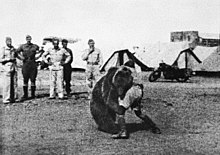
Wojtek initially had problems swallowing and was fed condensed milk from an old vodka bottle. He was subsequently given fruit, marmalade, honey, and syrup, and was often rewarded with beer, which became his favourite drink. He later also enjoyed smoking (or eating) cigarettes, as well as drinking coffee in the mornings. He also slept with the other soldiers if they were ever cold at night. He enjoyed wrestling with the soldiers and was taught to salute when greeted. He became an attraction for soldiers and civilians alike, and soon became an unofficial mascot to all the units stationed nearby. With the 22nd Company, he moved to Iraq, and then through Syria, Palestine, and Egypt.
Wojtek copied the other soldiers, drinking beer, smoking, and even marching alongside them on his hind legs because he saw them do so. Wojtek had his own caregiver, assigned to look after him. The cub grew up while on campaign, and by the time of the Battle of Monte Cassino, he weighed 90 kg (14 st; 200 lb).
Corporal Wojtek
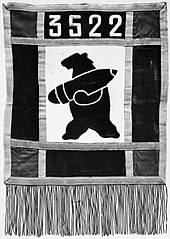
From Egypt, the Polish II Corps was reassigned to fight alongside the British Eighth Army in the Italian campaign. Regulations for the British transport ship, which was to carry them to Italy, forbade mascot and pet animals. To get around this restriction, Wojtek was officially drafted into the Polish Army as a private and listed among the soldiers of the 22nd Artillery Supply Company. Henryk Zacharewicz and Lew Worzowski were assigned as his caretakers.

As an enlisted soldier with his own paybook, rank, and serial number, he lived with the other men in tents or in a special wooden crate, which was transported by truck. During the Battle of Monte Cassino, Wojtek helped his unit to convey ammunition by carrying 100-pound (45 kg) crates of 25-pound artillery shells, never dropping any of them. While this story generated controversy over its accuracy, at least one account exists of a British soldier recalling seeing a bear carrying crates of ammunition. The bear mimicked the soldiers: when he saw the men lifting crates, he copied them. Wojtek carried boxes that normally required four men, which he would stack onto a truck or other ammunition boxes. This service at Monte Cassino earned him promotion to the rank of corporal. In recognition of Wojtek's popularity, a depiction of a bear carrying an artillery shell was adopted as the official emblem of the 22nd Company.
Postwar

After the end of World War II in 1945, Wojtek was transported to Berwickshire, Scotland, with the rest of the 22nd Company. They were stationed at Winfield Airfield on Sunwick Farm, near the village of Hutton, Scottish Borders. Wojtek soon became popular among local civilians and the press, and the Polish-Scottish Association made him an honorary member.
Following demobilisation on 15 November 1947, Wojtek was given to Edinburgh Zoo, where he spent the rest of his life, often visited by journalists and former Polish soldiers, some of whom tossed cigarettes for him to eat, as he did during his time in the army. He still happily responded to being spoken to in Polish, recognizing many of his former unit. Media attention contributed to Wojtek's popularity. He was a frequent guest on BBC television's Blue Peter programme for children.
Wojtek died 2 December 1963, aged 21, weighing nearly 500 kg (1,100 lb), and over 1.8 m (5 ft 11 in) tall.
Legacy
- The many memorials to the soldier-bear include a plaque within the collection of Imperial War Museum; a sculpture by David Harding in the Sikorski Museum, in London; and a wooden sculpture in Weelsby Woods, Grimsby.
- In 2013, the Kraków city council gave permission for the erection of a statue of Wojtek in the city's Jordan Park. It was unveiled on 18 May 2014, the 70th anniversary of the Battle of Monte Cassino.
- In 2013, the City of Edinburgh Council approved the erection of a bronze statue of Wojtek, by Alan Beattie Herriot, to stand in the city's West Princes Street Gardens. Unveiled in 2015, it presents Wojtek and a fellow Polish Army soldier walking together. An accompanying relief documents Wojtek's journey from Egypt to Scotland with the Polish Army.
- In 2016, a statue of Wojtek was unveiled in Duns, in the Scottish Borders. Wojtek had been stationed at the nearby Winfield Camp in 1946, alongside Polish troops. The statue was donated by the Polish town of Żagań, Duns's twin town, and was unveiled on 26 April 2016, 72 years after the Battle of Monte Cassino, which involved Polish forces, including Wojtek.
- In 2017, a street in Poznań, Poland, was named after Wojtek. The street, now named ulica Kaprala Wojtka (Corporal Wojtek Street), leads to the Poznań New Zoo.
- In September 2018 a wooden statue of Wojtek was unveiled in the Poznań New Zoo, funded by Krystyna Wieczorek, the author of a Polish book about Wojtek.
- In May 2019 a marble statue of Wojtek was unveiled in Cassino, Italy.
- Since 1 September 2019, the 80th anniversary of the outbreak of World War II, a statue of Wojtek the Soldier Bear has had a permanent place in Sopot, overlooking the street named after the Battle of Monte Cassino, in which he famously played a role.
- In 2024, the story of Wojtek was adapted into a play by writer Allan Pollock at Coventry's Albany Theater based on his children's book The Bear Who Went To War.
Monuments
In Poland-
In Jordan Park, Kraków
-
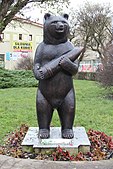 In Żagań
In Żagań
-
 In Szczecin
In Szczecin
-
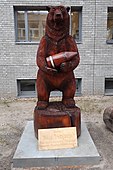 In the Nowe Miasto neighbourhood of Warsaw
In the Nowe Miasto neighbourhood of Warsaw
-
 Near a preschool named after him in the Ochota district of Warsaw
Near a preschool named after him in the Ochota district of Warsaw
-
 Unveiling of Wojtek's statue in Sopot
Unveiling of Wojtek's statue in Sopot
-
 In Szymbark
In Szymbark
-
 Plaque in the Imperial War Museum, London
Plaque in the Imperial War Museum, London
-
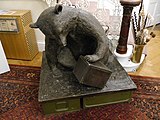 Sculpture by David Harding in the Sikorski Museum, London
Sculpture by David Harding in the Sikorski Museum, London
-
 Memorial statue, West Princes Street Gardens, Edinburgh, Scotland, 2022
Memorial statue, West Princes Street Gardens, Edinburgh, Scotland, 2022
-
 In Duns, Scotland
In Duns, Scotland
See also
- History of Edinburgh Zoo
- List of individual bears
- Poles in the United Kingdom
- Polish Armed Forces in the East
- Polish Armed Forces in the West
- Polish Resettlement Corps
- Wojtek Memorial Trust
- Winnipeg (bear)
References
- Martin Williams (2017). From Warsaw to Rome: General Anders' Exiled Polish Army in the Second World War. Pen & Sword Military. ISBN 978-1-47389-488-4.
One of the most popular recollections of the Polish Army in the East is that of Wojtek, the Syrian Brown Bear who became the mascot of 22 General Transport Company.
- ^ Mansolas, Angelos (2017). Monte Cassino January-May 1944: The Legend of the Green Devils. Fonthill Media. ISBN 978-1-78155-602-3.
The most unusual soldier of the Battle of Monte Cassino, or any other battle for that matter, was a bear named 'Wojtek'. He was a Syrian brown bear found in Hamedan, Iran in April 1942 by the troops of the newly formed 2nd Polish Corps during their long journey out of the Siberian labour camps through Middle East en route to Egypt.
- "Pomnik legendarnego niedźwiedzia Wojtka stanął w Krakowie" [Statue of the legendary bear Wojtek unveiled in Krakow]. Telewizja Polska (in Polish). 19 May 2014. Retrieved 24 December 2015.
- "O niedźwiedziu, który był polskim żołnierzem" [The bear who was a Polish soldier]. Polonia Włoska — Biuletyn Informacyjny (in Polish). Vol. 18, no. 1–2. 17 July 2013. p. 24. Retrieved 24 December 2015.
- "Meaning, Origin and History of the Name Wojciech". Behind the Name. 2014. Retrieved 15 August 2014.
- "Wojtek wraca" [Wojtek returns]. Polityka (in Polish). 2 February 2008. p. 11.
- "Smarter than the average bear .. by far". Edinburgh Evening News. 28 March 2007. Retrieved 15 August 2014.
- ^ "The Soldier Bear Who Went to War", BBC Outlook
- Sansone, Adele (9 July 2013). "'Private Wojtek' alias Voytek, ein Bär im Dienste der Armee" ['Private Wojtek' alias Voytek, a bear in the service of the Army]. Suite101 (in German). Retrieved 15 August 2014.
- "Wojtek the Bear: The Nazis' Furriest Enemy". Spiegel. 13 July 2012.
- Orr, Aileen (1 November 2010). Wojtek the Bear – Polish War Hero. Birlinn Publishers. p. 45. ISBN 978-1-84158-845-2.
- "The story of Wojtek – the soldier bear who was promoted to Corporal". iNews. 29 December 2017. Retrieved 22 June 2018.
- Mansolas, Angelos (2017). Monte Cassino January-May 1944: The Legend of the Green Devils. Fonthill Media. ISBN 978-1-78155-602-3.
At the time of his death, he weighed nearly 500 kilograms (1,100 lb) and over 1.8 metres (5'11 feet) tall.
- "Wojtek's sculpture". wojtekthebear.com. Retrieved 30 August 2021.
- "Polish soldiers meet Wojtek the bear ‒ Grimsby's tribute to Second World War heroes". Grimsby Telegraph. 29 October 2011. Archived from the original on 15 August 2014. Retrieved 15 August 2014.
- "Krakow votes for WWII soldier bear statue". Polskie Radio. 26 April 2013. Retrieved 15 August 2014.
- Polski, Pilnuj (13 May 2014). "Niedźwiedź Wojtek będzie miał swój pomnik w krakowskim Parku Jordana" [Wojtek the Bear will have his monument in Krakow's Jordana Park] (in Polish). Wpolityce.pl. Retrieved 15 August 2014.
- "The Statue". Wojtek Memorial Trust. Retrieved 31 March 2016.
- McCann, David (29 May 2013). "Prince Street Gardens statue of Polish army bear". The Scotsman. Retrieved 15 August 2014.
- "Niedźwiedź Wojtek w Princes Street Gardens" [Wojtek the Bear in Princes Street Gardens] (in Polish). Emito.net. 30 September 2013. Retrieved 15 August 2014.
- "Polish troops in Berwickshire". www.gavinton.net. Retrieved 17 October 2020.
- "Statue of hero bear Wojtek unveiled in Duns". The Scotsman. Retrieved 17 October 2020.
- Redakcja (24 January 2017). "Kapral Wojtek - dzielny niedźwiedź ma swoją ulicę w Poznaniu". Głos Wielkopolski (in Polish). Retrieved 1 March 2022.
- Redakcja (30 September 2018). "Zoo Poznań: Kapral Wojtek - Niezwykły niedźwiedź ma swój pomnik. W ogrodzie zoologicznym odbyło się oficjalne odsłonięcie". Głos Wielkopolski (in Polish). Retrieved 1 March 2022.
- S.A, Telewizja Polska. "Monument of Wojtek the Bear unveiled in Italy". tvpworld.com. Retrieved 1 March 2022.
- "Wojtek the Soldier Bear honoured on Monciak". 30 August 2019.
- Vanessa Pearce (30 October 2024). "The bear who was a private in the Polish army". bbc.com.
Further reading
- Anders, Władysław (1949). An Army in Exile, the Story of the Second Polish Corps. London: Macmillan.
- Kleczkowski, Stefan (1945). Poland's first 100,000: Story of the Rebirth of the Polish Army, Navy and Air Force After the September Campaign. London & New York: Hutchinson.
- Morgan, Geoffrey; Lasocki, Wiesław A. (1970). Soldier Bear. London: Collins. ISBN 0-00-211793-2.
- Dumon Tak, Bibi (2011). Soldier Bear. Grand Rapids, Michigan: Wm. B. Eerdmans Publishing Co. ISBN 978-0-8028-5375-2.
- Orr, Aileen (2012). Wojtek the Bear: Polish War Hero. Edinburgh: Birlinn Publishers. ISBN 978-1-84341-057-7.
- Ivell, Krystyna; Baczor, Vic (2013). Wojtek Album. London: Self-published. ISBN 978-0-9926327-0-0.
External links
- "Honour sought for 'Soldier Bear'". BBC News. London: BBC. 25 January 2008.
- WOJTEK: The unusual Polish soldier that drank beer and went to war.
- Polec, Patryk (2008). "Wojtek The Soldier Bear – In the Ranks of Victors". wojtek-soldierbear.weebly.com.
- "Wojtek the Bear". wojtekthebear.com. 2014.
- "Wojtek – the Soldier Bear – Niedźwiedź Żołnierz". Facebook. 2014. A group supporting and publicizing historical projects around the world.
- "Kresy-Siberia Virtual Museum". kresy-siberia.org. 2014. Archived from the original on 30 July 2021. Retrieved 15 August 2014. Site devoted to preserving the history into which Wojtek fits.
- Burman, J. (25 June 2011). "Polish veteran had special comrade". The Hamilton Spectator.
- Vennard, Martin (16 November 2011). "Story of Poland's 'soldier bear' Wojtek turned into film". BBC World Service.
- "Article in Polish with lots of links about Wojtek". Archived from the original on 6 November 2013. Retrieved 3 December 2013.
- One Photo One Story: Wojtek the Soldier Bear, Culture.pl.
- "WOJTEK The bear that went to war". Kresy Family.
- 1942 animal births
- 1963 animal deaths
- Battle of Monte Cassino
- Bear mascots
- Polish mascots
- Army mascots
- Real-life animal mascots
- Edinburgh Zoo
- Hamadan
- Individual animals in Scotland
- Individual bears
- Military animals of World War II
- Polish military personnel of World War II
- Military history of Poland during World War II
- Military of Scotland
- Polish Land Forces
- Polish military traditions
- Individual animals in Iran
- Individual animals in Poland